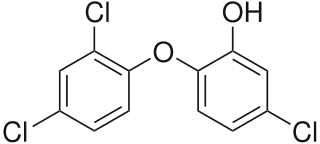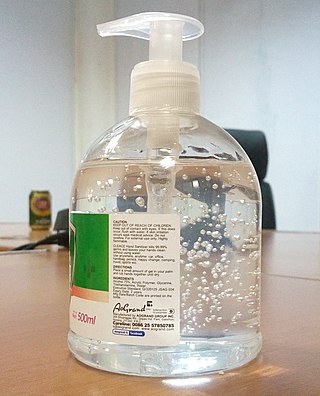Related Research Articles

Phenol, or Benzenol, is an aromatic organic compound with the molecular formula C6H5OH. It is a white crystalline solid that is volatile. The molecule consists of a phenyl group bonded to a hydroxy group. Mildly acidic, it requires careful handling because it can cause chemical burns.

The medical uses of silver include its use in wound dressings, creams, and as an antibiotic coating on medical devices. Wound dressings containing silver sulfadiazine or silver nanomaterials may be used to treat external infections. The limited evidence available shows that silver coatings on endotracheal breathing tubes may reduce the incidence of ventilator-associated pneumonia. There is tentative evidence that using silver-alloy indwelling catheters for short-term catheterizing will reduce the risk of catheter-acquired urinary tract infections.

A medication is a drug used to diagnose, cure, treat, or prevent disease. Drug therapy (pharmacotherapy) is an important part of the medical field and relies on the science of pharmacology for continual advancement and on pharmacy for appropriate management.

Antibacterial soap is a soap which contains chemical ingredients that purportedly assist in killing bacteria. The majority of antibacterial soaps contain triclosan, though other chemical additives are also common. The effectiveness of products branded as being antibacterial has been disputed by some academics as well as the U.S. Food and Drug Administration (FDA).

Triclosan is an antibacterial and antifungal agent present in some consumer products, including toothpaste, soaps, detergents, toys, and surgical cleaning treatments. It is similar in its uses and mechanism of action to triclocarban. Its efficacy as an antimicrobial agent, the risk of antimicrobial resistance, and its possible role in disrupted hormonal development remains controversial. Additional research seeks to understand its potential effects on organisms and environmental health.

Benzalkonium chloride, also known as alkyldimethylbenzylammonium chloride (ADBAC) and by the trade name Zephiran, is a type of cationic surfactant. It is an organic salt classified as a quaternary ammonium compound. ADBACs have three main categories of use: as a biocide, a cationic surfactant, and a phase transfer agent. ADBACs are a mixture of alkylbenzyldimethylammonium chlorides, in which the alkyl group has various even-numbered alkyl chain lengths.

Chlorhexidine is a disinfectant and antiseptic with the molecular formula C22H30Cl2N10, which is used for skin disinfection before surgery and to sterilize surgical instruments. It is also used for cleaning wounds, preventing dental plaque, treating yeast infections of the mouth, and to keep urinary catheters from blocking. It is used as a liquid or a powder. It is commonly used in salt form, either the gluconate or the acetate.

Pine tar is a form of wood tar produced by the high temperature carbonization of pine wood in anoxic conditions. The wood is rapidly decomposed by applying heat and pressure in a closed container; the primary resulting products are charcoal and pine tar.

Hexetidine is an anti-bacterial and anti-fungal agent commonly used in both veterinary and human medicine. It is a local anesthetic, astringent and deodorant and has antiplaque effects.

Povidone-iodine (PVP-I), also known as iodopovidone, is an antiseptic used for skin disinfection before and after surgery. It may be used both to disinfect the hands of healthcare providers and the skin of the person they are caring for. It may also be used for minor wounds. It may be applied to the skin as a liquid or a powder.
Neomycin/polymyxin B/bacitracin, also known as triple antibiotic ointment, is an antibiotic medication used to reduce the risk of infections following minor skin injuries. It contains the three antibiotics neomycin, polymyxin B, and bacitracin. It is for topical use.

Hexachlorophene, also known as Nabac, is an organochlorine compound that was once widely used as a disinfectant. The compound occurs as a white odorless solid, although commercial samples can be off-white and possess a slightly phenolic odor. It is insoluble in water but dissolves in acetone, ethanol, diethyl ether, and chloroform. In medicine, hexachlorophene is useful as a topical anti-infective and anti-bacterial agent. It is also used in agriculture as a soil fungicide, plant bactericide, and acaricide.

Merbromin is an organomercuric disodium salt compound used as a topical antiseptic for minor cuts and scrapes and as a biological dye. Readily available in most countries, it is no longer sold in Switzerland, Brazil, France, Iran, Germany, Denmark, or the United States due to its mercury content.

Hand sanitizer is a liquid, gel or foam generally used to kill many viruses/bacteria/microorganisms on the hands. In most settings, hand washing with soap and water is generally preferred. Hand sanitizer is less effective at killing certain kinds of germs, such as norovirus and Clostridium difficile, and unlike hand washing, it cannot physically remove harmful chemicals. People may incorrectly wipe off hand sanitizer before it has dried, and some are less effective because their alcohol concentrations are too low.

Lotion is a low-viscosity topical preparation intended for application to the skin. By contrast, creams and gels have higher viscosity, typically due to lower water content. Lotions are applied to external skin with bare hands, a brush, a clean cloth, or cotton wool.
Dakin's solution is a dilute solution of sodium hypochlorite and other stabilizing ingredients, traditionally used as an antiseptic, e.g. to cleanse wounds in order to prevent infection. The preparation was for a time called also Carrel–Dakin solution or Carrel–Dakin fluid.

Benzethonium chloride, also known as hyamine is a synthetic quaternary ammonium salt. This compound is an odorless white solid, soluble in water. It has surfactant, antiseptic, and anti-infective properties, and it is used as a topical antimicrobial agent in first aid antiseptics. It is also found in cosmetics and toiletries such as soap, mouthwashes, anti-itch ointments, and antibacterial moist towelettes. Benzethonium chloride is also used in the food industry as a hard surface disinfectant.

Lysol is a brand of American cleaning and disinfecting products distributed by Reckitt, which markets the similar Dettol or Sagrotan in other markets. The line includes liquid solutions for hard and soft surfaces, air treatment, and hand washing. The active ingredient in many Lysol products is benzalkonium chloride, but the active ingredient in the Lysol "Power and Free" line is hydrogen peroxide. Lysol has been used since its invention in the late 19th century as a household and industrial cleaning agent, and previously as a medical disinfectant.

Brilliant green is one of the triarylmethane dyes. It is closely related to malachite green.

Chlorine-releasing compounds, also known as chlorine base compounds, is jargon to describe certain chlorine-containing substances that are used as disinfectants and bleaches. They include the following chemicals: sodium hypochlorite, chloramine, halazone, and sodium dichloroisocyanurate. They are widely used to disinfect water and medical equipment, and surface areas as well as bleaching materials such as cloth. The presence of organic matter can make them less effective as disinfectants. They come as a liquid solution, or as a powder that is mixed with water before use.
References
- 1 2 Creagh, Gerard R. (January 1943). "Battle Casualties Aboard a Light Cruiser". United States Naval Medical Bulletin. XLI (4): 939.
- ↑ Smyth, Calvin M. (1943). Piersol, George Morris (ed.). "Modern Treatment of Burns". Clinics. Philadelphia: J.B. Lippincott. 2 (1): 210.
- ↑ Atkins, H. J. B. (1942). "War Surgery Of The Extremities: The Management Of Burns (Concluded)". The British Medical Journal . 1 (4249): 729–731. ISSN 0007-1447. JSTOR 20323395.
- ↑ Cope, Zachary, ed. (1953). Surgery. London: HMSO. p. 294. OCLC 559262204.
- ↑ Buchin, Irving (August 1945). "Drugs in treatment of periodontal disease". The Bulletin of the U. S. Medical Department. Washington, DC. IV (2): 212.
- 1 2 Wolf, Kevin J (6 September 2016). "Safety and Effectiveness of Consumer Antiseptics; Topical Antimicrobial Drug Products for Over-the-Counter Human Use". Federal Register . 81 (172): 61106–61130.
- ↑ Roth, Philip (2011). "Neonatology". Pediatric Secrets: 423–479. doi:10.1016/B978-0-323-06561-0.00012-4. ISBN 9780323065610.